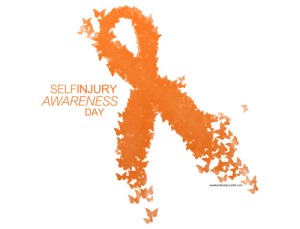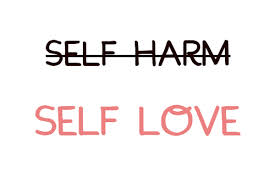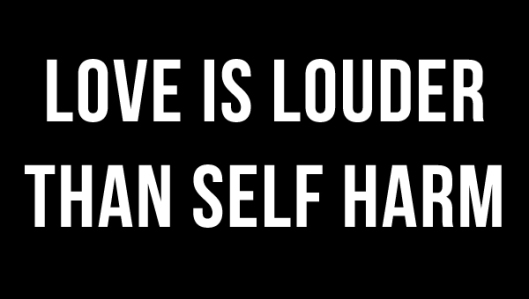Tags
Burning, Cutting, Depression, How to help with cutting, Mental Illness, Pain, Self-harm, Self-Injure, Support
March 1st was Self-Injury Awareness Day. We are a little late on posting, but it’s never too late to learn and understand it!
Self-Injury, also referred to as self-harm, is very real and very important to understand.
We will start with the definition first, then move on to myths so we can get any misconceptions out of the way.
Self-Injury/Self-Harm: the deliberate act of harming your own body. Which can include cutting, burning (with cigarettes, hot knives, matches, etc.), pulling hair out, and head banging. Self-Harm can also be acted through excessive drinking and doing drugs.
There are many myths about self-harming. If these myths are projected onto the one struggling, it can make matters worse. Having facts to these myths can help people become more aware of what is going on.
Myths:
(Segal & Smith, 2015)
- Myth: People who self-harm/self-injure are doing it to get attention: No, no, no! People who are self-harming are usually doing it in secret. They try to avoid having others see their wounds by covering it up with clothes. They are not acting out, trying to manipulate others, or asking for attention! It’s very hard for someone to come out and ask for help. If this is said to anyone who is self-harming, you can bet that they will feel more ashamed and guilty that they will never ask for help.
- Myth: If their wounds “aren’t that bad,” it doesn’t mean it’s not serious: How bad the wounds are has nothing to do with how much they are hurting inside. Don’t assume that nothing is wrong because the wounds are “minor.”
- Myth: People who self-injure are crazy and/or dangerous to others: People who self-harm are usually suffering from mental illnesses such as depression, anxiety or trauma. Just like millions of others who are suffering from the same thing. Self-Injury is a coping strategy. Not a healthy one, but still a strategy none-the-less. Putting these labels on them is not truthful, and it is not helping anyone.
- Myth: All people who self-injure wants to die: People who self-injure do not want to die, they just want the pain to stop. They use this to cope with their pain, not a way to end their life. However, anyone who is self-harming should go and seek help!
Signs of Self-Injury:
(Segal & Smith, 2015)(National Society for the Protection of Cruelty to Children, 2015)
- Physical:
- Unexplained cuts, bruises or burns. Which leads to claims of them having.Numerous “accidents” that created those cuts, bruises, or burns.
- Blood stains on clothing, sheets, towels, or tissues.
- Covers body (such as long sleeves or pants), even when it’s hot outside.
- Emotional:
- Signs of depression such as feeling sad, lonely, hopeless, or helpless.
- Needing to be alone for a long period of time, such as in their bedroom or the bathroom. (This sign alone does not mean they are self-harming)
- Irritability
- Statements of worthlessness, hopeless, or helpless.
- May feel the need to carry sharp objects with them .
Why do people Self-Injure?
(Segal & Smith, 2015)
People self-injure as a way to cope with how they are feeling. But there are many reasons as to why people hurt themselves.
- They feel a sense of release.
- They feel like they deserve to be injured (because of guilt, shame, or low self-esteem)
- Feels like they are in control.
- Distracts them from how they are feeling emotionally.
- Makes them feel alive if they are feeling numb inside.
From the sounds of the bullets above, it sounds like it’s ok, but it’s not! This is not a healthy coping strategy! The feelings they get when they hurt themselves is only temporary, and can create more problems in the future:
- Once the act is done, they can feel guilt or shame for doing it (especially if a family member or friend knows about their struggle).
- It can become an impulsive habit: anything can trigger it and they will feel the need to do the behavior.
- Keeping it as a secret from family and friends can create a sense of isolation, guilt and loneliness.
How to help if YOU are struggling:
(Segal & Smith, 2015)(Mayo Clinic, 2015)
- Tell somebody! Sharing your struggle can feel like a weight is lifted off your shoulders. Having that support will help you through!
- Figure out your triggers and feelings that make you want to cut. Understanding these can help you create a plan to help manage, or stay away from those triggers.
- Learn new ways to cope. There are more healthy ways to cope with this. Seek a professional and they can help. Or it can be as easy as doing something you enjoy, like sports, art or pets.
- Like above, go see a professional. They can not only help you with the self-harm, but they can help you process and understand what you are feeling and better ways to cope.
How to help if someone you love is struggling:
(Segal & Smith, 2015) (Mayo Clinic, 2015) (National Society for the Protection of Cruelty to Children, 2015)
- Do not judge them! Listen with an open mind and an open heart and try to understand their feelings, not judge them.
- Deal with your own feelings about it on your own time. You might feel shocked, confused, etc., but do not project these feelings onto them. Projecting those feelings can make them feel guilty, which is what we do not want! And if you, the helper, is feeling guilt, understand that it is not your fault either.
- Do not to jump to conclusions or reasons why this is happening; this can create anxiety.
- Help them figure out their triggers. Having this open communication can help them trust you along with helping them get through this. Listen carefully and try to make a plan on how to stay away from those triggers together.
- Offer support, not punishment. It’s understandable to feel scared when someone you love is telling you that they are hurting themselves. But stay calm, and tell them that you are there for them. Do not punish them! Grounding them and making them stay in their room and taking away every single sharp object will not help the situation. It can make them feel guilt, and feel even more lonely for their feelings and behaviors.
- Don’t shadow your child, or friend. Again, it’s understandable to be scared in this situation, but think about how it would make them feel. This can make them feel like you do not trust them and, again, make them feel guilt.
- Encourage communication. Talking about it once will not help them feel supported. A constant open communication can build trust and self-esteem.
- Learn about it. The internet is a great place to gather information to better understand your loved one and the situation. Below, in the references, will be a couple of websites that we recommend you go to.
- Take them to go see a professional. They alone might not want to and might feel scared to go, but encourage it. Therapists can help them with better coping strategies and help them with how they are feeling.
- Be respectful of what they told you and who you should tell. They told you because they trust you (or want to trust you), so don’t go and tell every family member or every friend you know. Tell someone only if it will help your loved one with their struggle.
- MOST IMPORTANTLY: tell them you love them no matter what.
Self-injury/self-harm is nothing to take lightly. It means that someone is in pain. Sit down and talk to them, show them support.
If you, or a loved one, is struggling with self-harm, there are lots of resources to help:
- Look for a local therapist
- Call a help-line:
- 1 (800) 273 – TALK (8255) – a 24 hour crisis helpline.
- 1 (800) 334 – HELP (4357) – a 24 hour crisis line from the Self Injury Foundation
- 1 (800) SUICIDE (784- 2433) – a helpline if you, or someone you love, is considering suicide.
- 1 (800) DONTCUT (366-8288) – S.A.F.E (Self-Abuse Finally Ends) Alternatives helpline for more information on self-harm
- Look to websites for help:
- To Write Love On Her Arms (http://www.TWLOHA.com) – A non-profit movement dedicated to presenting hope and finding help for people struggling with depression, addiction, self-injury, and suicide.
- http://www.selfinjury.com – Referrals for therapists and tips for how to stop.
- http://www.helpguide.org/articles/anxiety/cutting-and-self-harm.htm
References:
Mayo Clinic. (2015). Self-Injuiry/Cutting. Retrieved March 2015, from MayoClinic: http://www.mayoclinic.org/diseases-conditions/self-injury/basics/definition/con-20025897
National Society for the Prevention of Cruelty to Children (NSPCC). (2015). Self-Harm: Find out how to spot the signs and what you can do to help. Retrieved March 2015, from NSPCC: http://www.nspcc.org.uk/preventing-abuse/keeping-children-safe/self-harm/
Segal, P. J., & Smith, M. M. (2015, February). Cutting and Self-Harm: Self-Injury Help, Support and Treatment. Retrieved March 2015, from HelpGuide: http://www.helpguide.org/articles/anxiety/cutting-and-self-harm.htm


